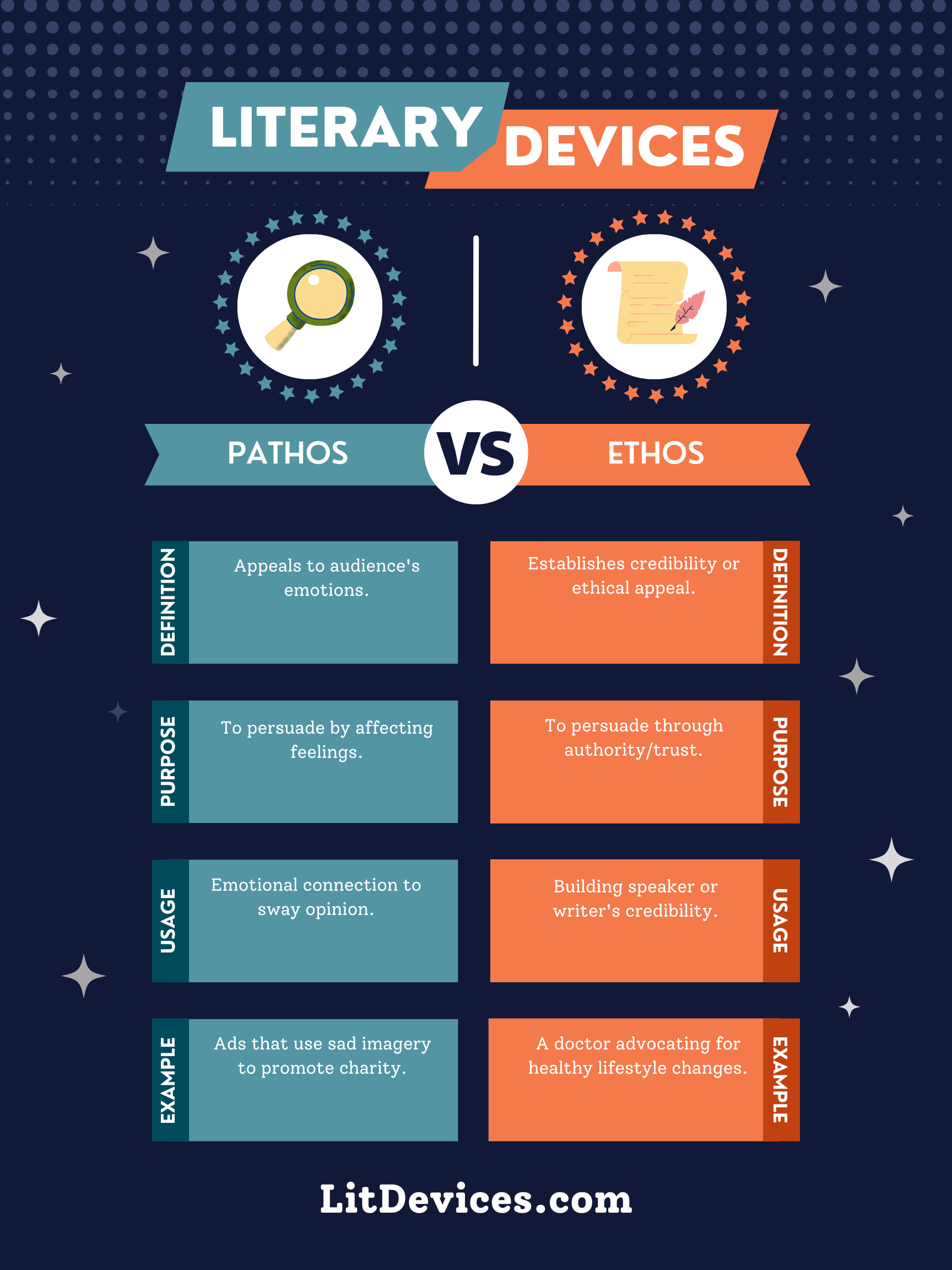Pathos appeals to emotion to persuade; Ethos appeals to ethics or credibility.
Pathos
Pathos is a rhetorical device that an author or speaker uses to appeal to the audience’s emotions, aiming to elicit feelings that prompt action or persuade. It can be achieved through storytelling, vivid imagery, or personal anecdotes.
💔 Example: In Martin Luther King Jr.’s “I Have a Dream” speech, he uses pathos by painting a vivid picture of a future where children of all races can coexist harmoniously, appealing to the audience’s desire for peace and equality.
Ethos
Ethos is used to establish the author’s or speaker’s credibility and trustworthiness in the eyes of their audience. This can be achieved through demonstrating knowledge of the subject, displaying good character, or showing respect for the audience.
📚 Example: In her speeches, Malala Yousafzai often draws on her own experiences of fighting for girls’ education in Pakistan, establishing her ethos by highlighting her firsthand knowledge and commitment to the cause.
Summary
| Literary Device | Definition | Purpose | Usage | Relevant Examples |
|---|---|---|---|---|
| Pathos | Appeals to the audience’s emotions to persuade or motivate. | To connect with the audience on an emotional level, making the message more compelling. | Used in speeches, literature, and advertisements to evoke sympathy, anger, happiness, etc. | MLK’s “I Have a Dream” speech. |
| Ethos | Appeals to ethics or credibility to establish trust and authority. | To establish the speaker or writer as a reliable, ethical source worthy of the audience’s trust. | Common in persuasive writing, speeches, and academic work to build rapport with the audience. | Malala Yousafzai’s advocacy speeches. |
Writing Tips
When incorporating pathos or ethos into your writing:
- For Pathos: Understand your audience’s values, fears, and hopes. Use vivid imagery, emotional language, and relatable examples to create a strong emotional connection.
- For Ethos: Build your credibility by demonstrating expertise, fairness, and goodwill. Reference credible sources, share personal experiences related to the topic, and acknowledge counterarguments respectfully.
🖋 Example for Pathos: When writing about climate change, share personal stories or evoke imagery of affected wildlife to stir emotions and urge action.
🖋 Example for Ethos: If arguing for a new educational policy, cite your experience as an educator, use statistical evidence from reputable sources, and address potential concerns thoughtfully.
FAQs
Can pathos and ethos be used together?
Absolutely. Combining emotional appeal with credibility makes arguments more persuasive and multifaceted.
How do I choose between pathos and ethos?
Consider your purpose and audience. If aiming to motivate or connect emotionally, pathos is key. To establish credibility or argue logically, focus on ethos.
Is one more effective than the other?
Effectiveness depends on the context and audience. A balanced approach often yields the best results.
Exercise
Identify whether the following are examples of pathos or ethos:
- A lawyer details the suffering of a client’s family in court to garner sympathy from the jury.
- A doctor writes an article about the benefits of vaccination, citing years of research and personal experience treating patients.
- An advertisement features testimonials from happy customers to demonstrate the effectiveness of a product.
- A politician discusses their humble beginnings to connect with voters from similar backgrounds.
Answers:
- Pathos
- Ethos
- Pathos (could also be seen as ethos if focusing on the credibility of the customers)
- Pathos (but also builds ethos through shared experiences)
Interesting Literary Device Comparisons
- Logos vs Pathos: Logos appeals to logic and reason, using facts, evidence, and logical arguments to persuade, while pathos targets the audience’s emotions.
- Anecdote vs Analogy: An anecdote is a short, personal story used to illustrate a point, often appealing to pathos, while an analogy is a comparison between two things for the purpose of explanation or clarification, often used in logos arguments.
- Metaphor vs Simile: Both are comparative devices used to enhance descriptions; a metaphor asserts two things are the same for effect, while a simile uses “like” or “as” to compare. These can be

